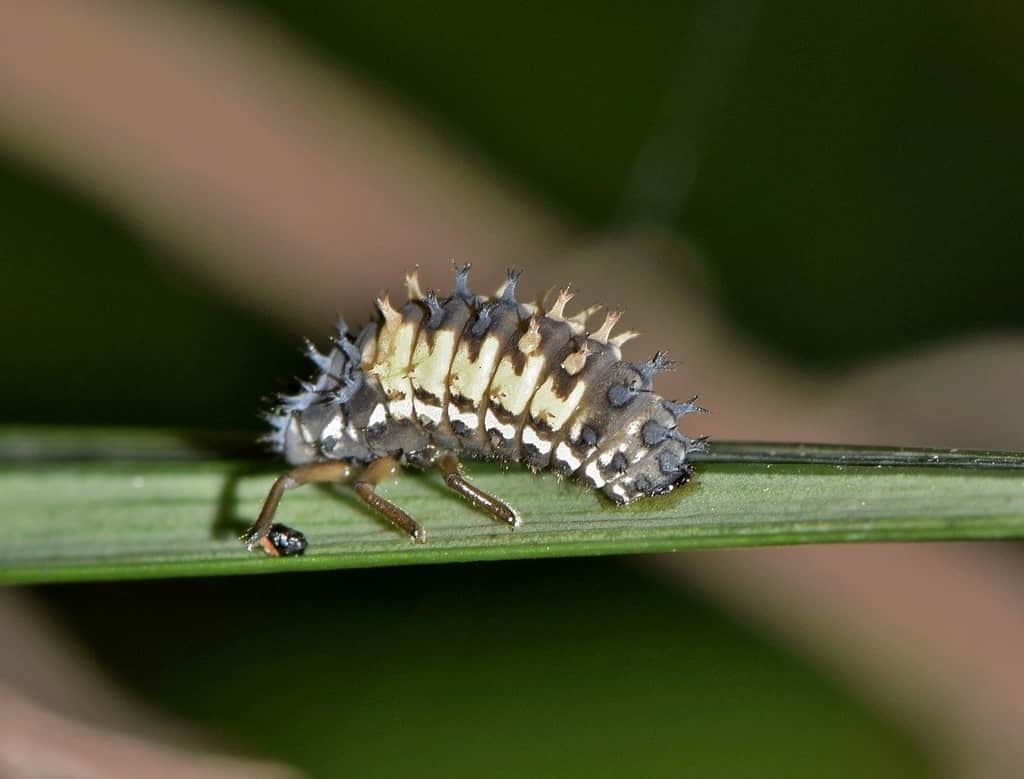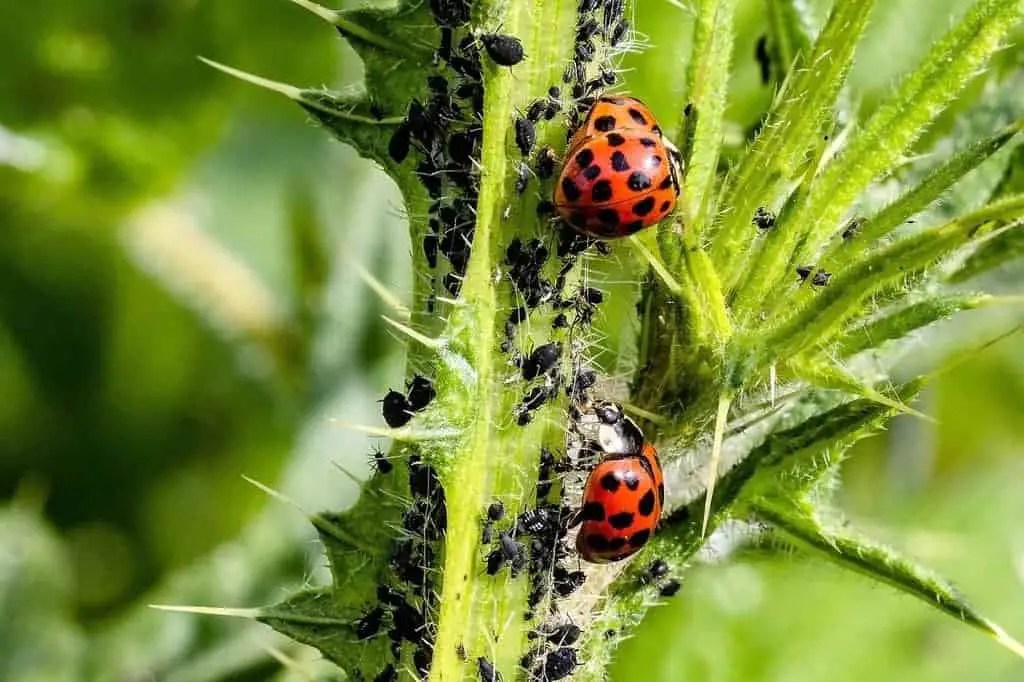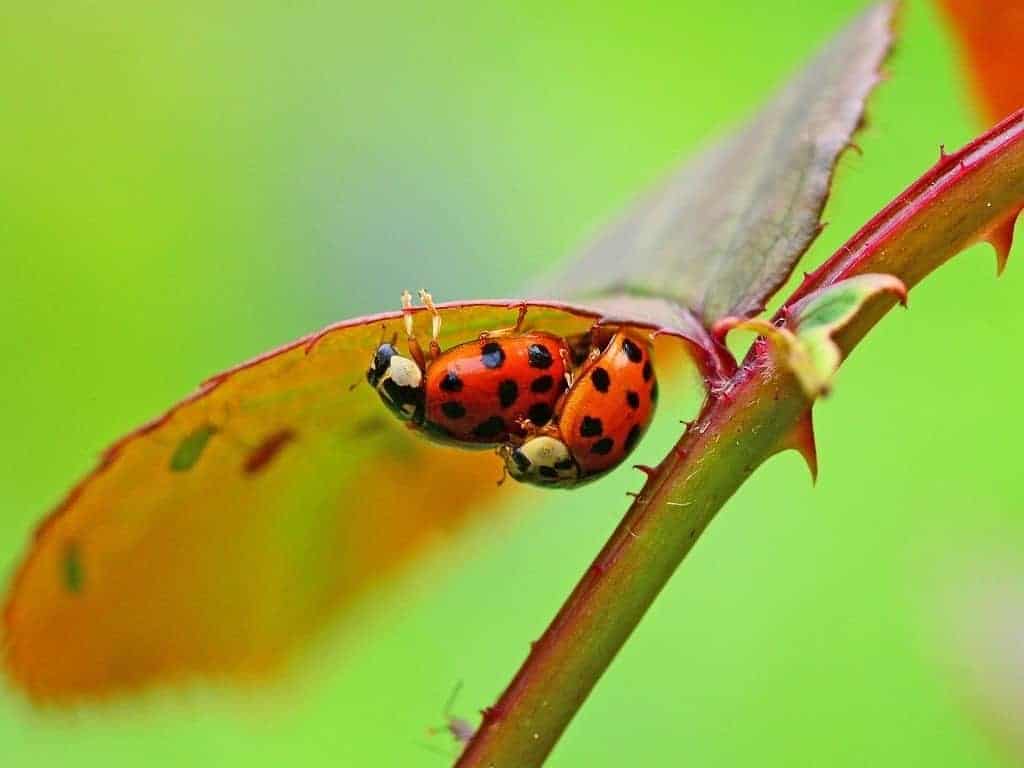Ladybugs are cute little creatures that you can keep at home. It is even possible to breed them if you want. In this article, I’ll teach you all you need to know about ladybug care to make your pet ladybug happy and healthy.
To keep ladybugs as pets, place them in a small, ventilated container. Decorate it with small plants, twigs, and miniature figurines. Feed them with 10% syrup solution or raisins. If possible, feed them with aphids or mealybug. To reproduce, they need to feed on aphids or other prey. The ladybug larvae are predators.
Taking care of ladybugs is easy and hassle-free, especially if you don’t plan to breed them. Continue reading to understand more on their behaviors and how to keep them healthy.
How can I Get Ladybugs
Ladybugs are not easy to breed due to their dietary requirements. Not many sellers are selling ladybugs because of that. You can try searching them in your online social marketplace. There is a starter kit (affiliate link) listed in Amazon that you can buy directly.

Your best bet is to catch them from the field in late spring to summer. Look for places with vegetation such as a garden, crop fields, or park. Simply sweep over the foliage using a butterfly net at the same spot for a few times. Then, check the net and contain any ladybugs caught using a vial. Do remember not to trespass and to get permission if you are hunting outside your premises.
When the weather turns cooler in the fall, the ladybugs tend to congregate for warmth. You can find them hiding underneath rocks, fallen leaves, tree crevices and etc. Sometimes it may even invade people’s houses and become a nuisance. If you see them in your house, you can catch them using a small vial.
You might be wondering why don’t you catch the larvae instead of adult ladybugs. Well, you can do that if you are able to identify the larvae. Adult ladybugs are way more conspicuous than the larvae.

Another method that you can try is to use blacklight at night. Find an open field around a park or garden, away from light sources. Shine your blacklight onto a hanged white cloth. This will attract ladybugs, along with all sorts of insects, toward the black light.
Preparation of Housing for Ladybugs
Ladybugs can be housed in a simple deli container. Make a few holes on the wall or lid of the container for ventilation. The vents must be smaller than the size of the ladybugs, so they cannot escape.
Decorate the housing with small plants, twigs, rocks, or even a miniature figurine. This provides a shelter for the ladybugs to hide within whenever they want to.
However, to fully enjoy keeping ladybugs, I would strongly recommend you to house them in a miniature terrarium.
Choose a terrarium with a cap so that you can open it to replenish food supply. The opening of the terrarium should also be big enough for you to comfortably put in or remove the dish plate (at least through a forceps).
Many commercially available terraria used to house live plants comes with a screen or mesh for ventilation. Always check if the vents are small enough to prevent the ladybugs from escaping. If you can’t find the vents, ask the seller. Some terraria may have concealed vents for aesthetic purposes.
How to Feed Ladybugs
You can feed the ladybugs with 10% syrup. Simply dissolve sugar with water in a 1:9 ratio. Pour the syrup into a small container (eg. a bottle cap) and fit a cotton ball or sponge into that container. This allows the ladybugs to feed on the syrup without drowning.
Change the cotton or wash the sponge and replenish the syrup every week. Be careful when replenishing the syrup to prevent spillage.
If you prefer to give them solid food, you can also feed them with raisin. Soak a piece of raisin in water for a few minutes to soften it. Place the softened raisin in a bottle cap and offer it to your ladybugs. Add more raisin once the existing one is consumed. Replace unconsumed raisin every 3 – 4 days.

If you want your ladybugs to live healthier and longer, you need to offer them aphids or mealybugs. In fact, the female ladybugs will not lay any viable eggs if she is provided with only syrup. In addition to that, many ladybug larvae cannot survive to adulthood without their prey.
But where can you find aphids? Try to search for aphids in the park or garden at where you caught your ladybugs. The aphids tend to congregate underneath the leaves or stem. They might be guarded by ants, where they form a symbiotic relationship. Pluck the infested foliage and put it into a jar, brush them off the foliage, or tap the infested leaf so that the aphids fall into your container.
Similarly, you can find mealybugs in gardens, especially on flowers and fruit-bearing plants such as citrus, grapes, pineapple, papaya, mulberry, sunflower and orchids. Mealybugs may also be guarded by ants. The easiest way to collect them is to cut the foliage on which they are found.
You can then transfer the prey to your terrarium using a brush whenever you want to feed your ladybugs. Ladybugs prefer live prey. Be careful not to kill the prey when transferring them.
If you are lucky, you may find people selling aphids or mealybugs online. It can be quite expensive though. For instance, Nasco is selling 100 aphids at USD 24 at the time of writing.
Do note that some ladybugs are herbivorous and you don’t need to offer them insect prey.
Temperature, Lighting and Humidity for Keeping Ladybugs
The ladybugs can survive well under room temperature. Additional lighting is not required, but it is good to have one when you want to observe this tiny creature.
You can leave a piece of wet paper towel in the housing. This will provide enough moisture for the ladybugs. Alternatively, mist the terrarium regularly to keep it moist.
Considerations should be given on caring for the plants if you are using a terrarium with live plants.
Breeding Ladybugs

Aphids or mealybugs is the staple diet for predatory ladybugs. You must feed your ladybugs with aphids or mealybugs if you want to breed them.
When placed in the same container, the male ladybug will mount the female and mate. Eventually the female will lay eggs. Eggs typically hatch in 3-5 days into larvae. Larvae prey on soft-bodied insects such as aphids and mealybugs
If possible, separate the larvae from the adults. When there isn’t enough food, the adult ladybugs may cannibalize their larvae.
The larvae molt several times into pupae in 2 weeks. The pupa doesn’t move nor eat. The adult ladybug emerges from the pupa in about a week’s time.
Adult ladybugs can live for 2-12 months depending on species, food and temperature.
Releasing the Ladybugs
At some point of time, you might consider releasing the ladybugs either because you want them to control the aphids in your garden, or because you want to give them freedom after observing them.
You should release your ladybugs in spring or summer so that they can still get rid of some aphids. If you release them in the fall, they may end up looking for shelter in someone else’ home. In such cases, they may be treated as pest!
In the winter, ladybugs can tolerate the cold temperature through supercooling, where it lowers the freeze temperature of its body fluid. They survive by relying on their energy reserve which they have built-up prior to the winter.
Do not release exotic species to the wild!
How to Handle Ladybugs
Ladybugs are small and fragile. Handle them with extra care so that you don’t accidentally kill them. You can use a brush or a pen to coax them to move around if you need to transfer them from one place to another.
Note that ladybugs are good fliers. Watch out when handling them and replenishing the food.
Quick Facts
How did ladybugs get their name?
Once upon a time, there were farmers praying to the Virgin Mary to get rid of the pests destroying their crops. The ladybugs came and killed all the pests. They were originally called “the birds of our Lady”, and eventually became “ladybirds”. It was then adapted to “ladybugs” in the United States. Entomologists call them lady beetles because technically they are not “bugs”.
Are all ladybugs beneficial insects?
Not all ladybugs are beneficial insects. Certain species do not prey. Instead, they feed on crops such as maize, beans, and cotton. Those species are generally minor agricultural pests.
Are ladybugs poisonous?
Ladybugs are not poisonous. The bright colors on ladybug’s elytra (hardened forewings) warn predators that it is not worth attacking them. However, that’s just a hoax to scare them off.
Are all ladybugs red or yellow in color?
Ladybugs can be red, yellow, amber, black or brown in color.
Why is my ladybug bleeding?
When threatened, ladybugs excrete hemolymph (blood) with unpleasant odor to deter their predator. You don’t have to worry about that as it causes you no harm.
Does the number of spots on ladybugs tell you their age?
The patterns and number of spots on a ladybug’s wings are species-specific. It doesn’t represent their age nor sex.
For instance, the seven-spotted ladybugs and two-spotted ladybugs obviously have 7 spots and 2 spots respectively. Twelve-spotted ladybugs commonly found in North America have 12 spots.
Certain species have stripes instead of spots, while some have no pattern on their elytra at all.
How do I sex ladybugs?
Generally females are larger than males. If you see a ladybug mounting on another ladybug, the one at the bottom is the female.
My ladybug often faints! What should I do?
Ladybugs play dead when they sense danger. You don’t have to worry about that. They will come back to live once they feel safe.



